Opportunities & Problems of Social E-Commerce: A Comprehensive Report
VerifiedAdded on 2020/03/01
|13
|2877
|53
Report
AI Summary
This report delves into the multifaceted world of social e-commerce, examining its opportunities and challenges. It begins by highlighting the transformative impact of the internet on e-marketplaces and the consistent delivery of transactions within a dynamic environment. The report identifies key opportunities such as e-business integration, open and distance learning, and the evolving role of e-commerce in insurance. It also addresses the challenges, including ethical concerns like privacy and security, and the complexities of risk perception in online encounters. The analysis extends to the economic implications for developing countries and the role of the WTO, as well as the evolving landscape of future media in e-commerce. The report provides a comprehensive overview of the current state and future prospects of social e-commerce, including the importance of e-commerce education and the need for businesses to adapt to the changing digital landscape.
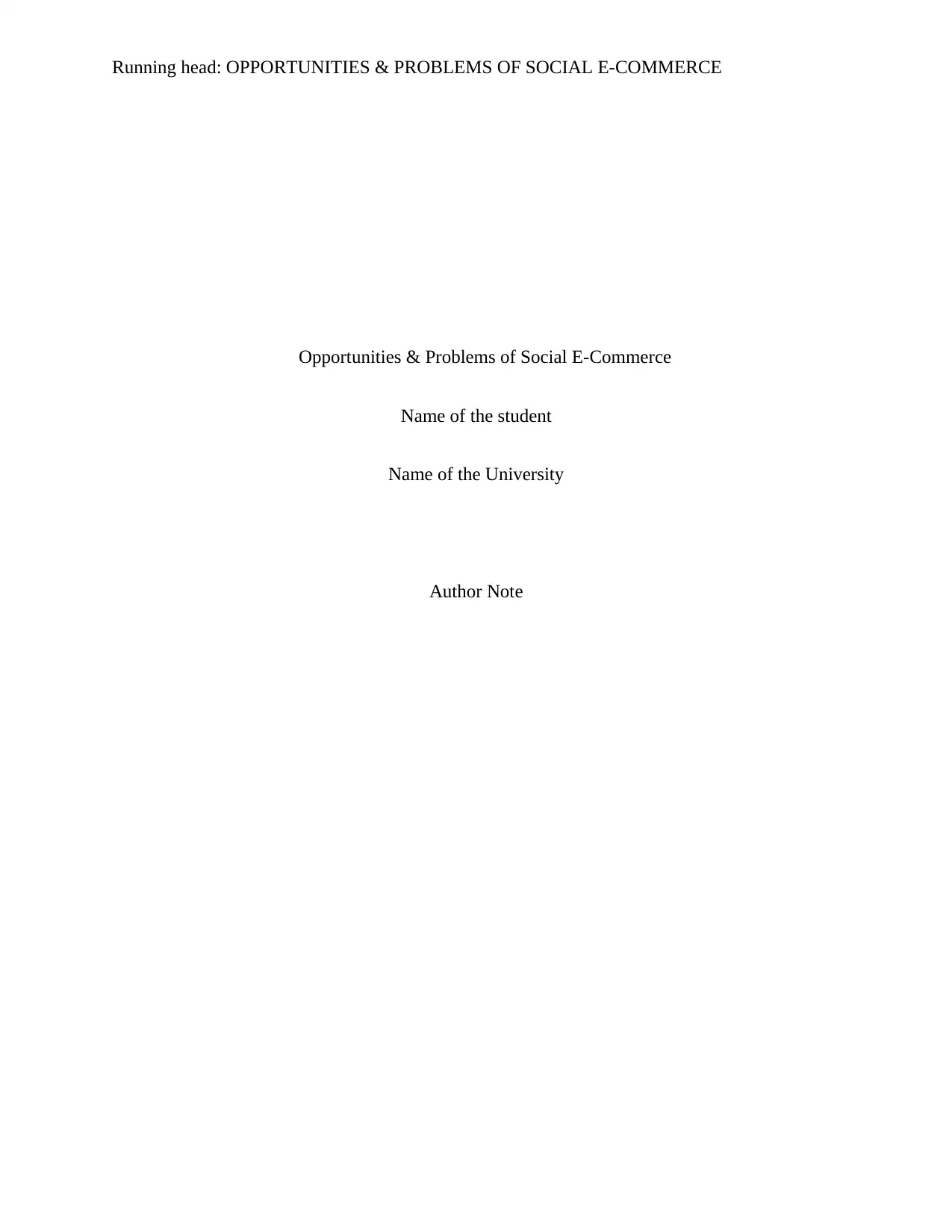
Running head: OPPORTUNITIES & PROBLEMS OF SOCIAL E-COMMERCE
Opportunities & Problems of Social E-Commerce
Name of the student
Name of the University
Author Note
Opportunities & Problems of Social E-Commerce
Name of the student
Name of the University
Author Note
Paraphrase This Document
Need a fresh take? Get an instant paraphrase of this document with our AI Paraphraser
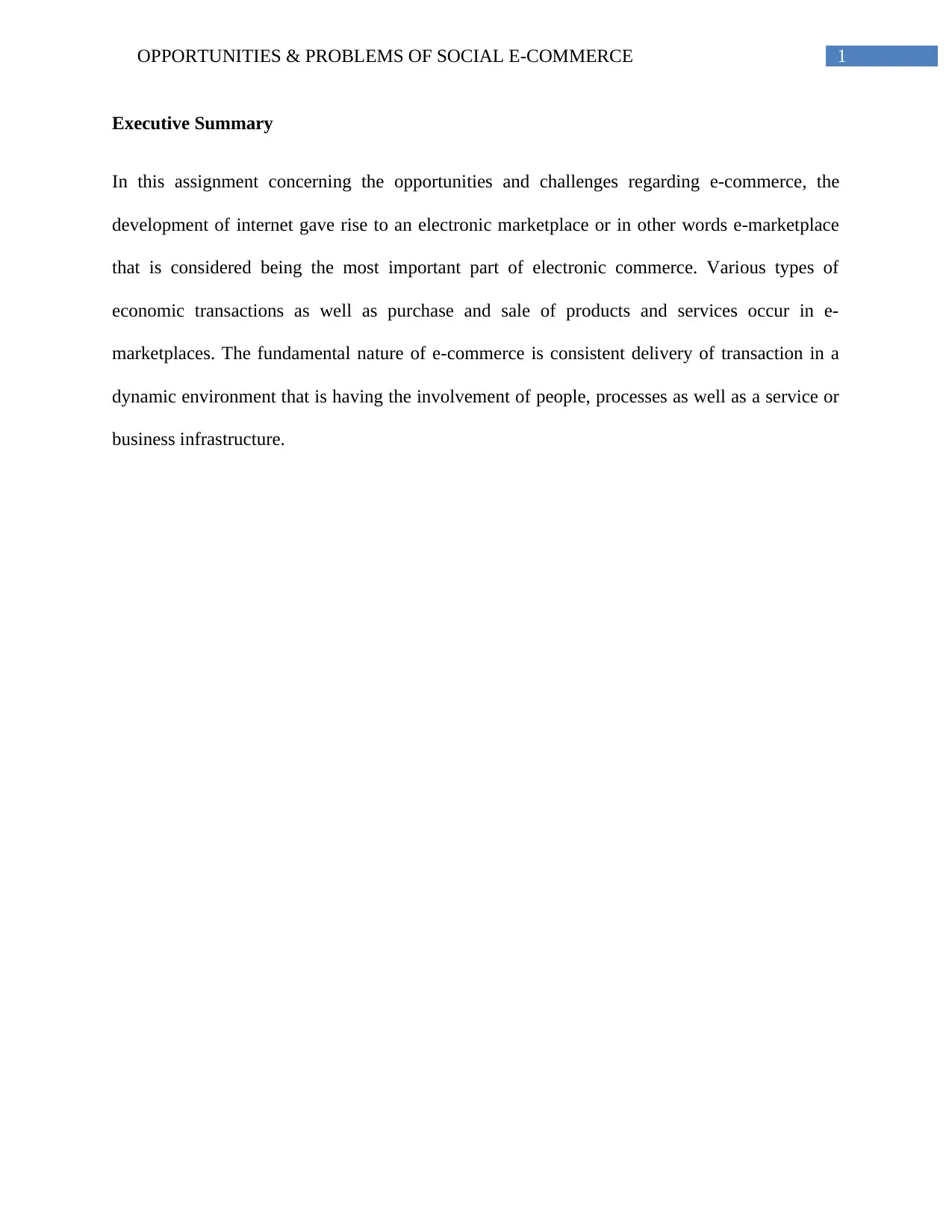
1OPPORTUNITIES & PROBLEMS OF SOCIAL E-COMMERCE
Executive Summary
In this assignment concerning the opportunities and challenges regarding e-commerce, the
development of internet gave rise to an electronic marketplace or in other words e-marketplace
that is considered being the most important part of electronic commerce. Various types of
economic transactions as well as purchase and sale of products and services occur in e-
marketplaces. The fundamental nature of e-commerce is consistent delivery of transaction in a
dynamic environment that is having the involvement of people, processes as well as a service or
business infrastructure.
Executive Summary
In this assignment concerning the opportunities and challenges regarding e-commerce, the
development of internet gave rise to an electronic marketplace or in other words e-marketplace
that is considered being the most important part of electronic commerce. Various types of
economic transactions as well as purchase and sale of products and services occur in e-
marketplaces. The fundamental nature of e-commerce is consistent delivery of transaction in a
dynamic environment that is having the involvement of people, processes as well as a service or
business infrastructure.

2OPPORTUNITIES & PROBLEMS OF SOCIAL E-COMMERCE
Table of Contents
Introduction......................................................................................................................................3
Project Objective.............................................................................................................................3
Project Scope...................................................................................................................................4
Literature Review............................................................................................................................4
Opportunities regarding E-Commerce.........................................................................................4
Challenges concerning E-Commerce..........................................................................................8
Conclusion.....................................................................................................................................10
Reference.......................................................................................................................................11
Table of Contents
Introduction......................................................................................................................................3
Project Objective.............................................................................................................................3
Project Scope...................................................................................................................................4
Literature Review............................................................................................................................4
Opportunities regarding E-Commerce.........................................................................................4
Challenges concerning E-Commerce..........................................................................................8
Conclusion.....................................................................................................................................10
Reference.......................................................................................................................................11
⊘ This is a preview!⊘
Do you want full access?
Subscribe today to unlock all pages.

Trusted by 1+ million students worldwide
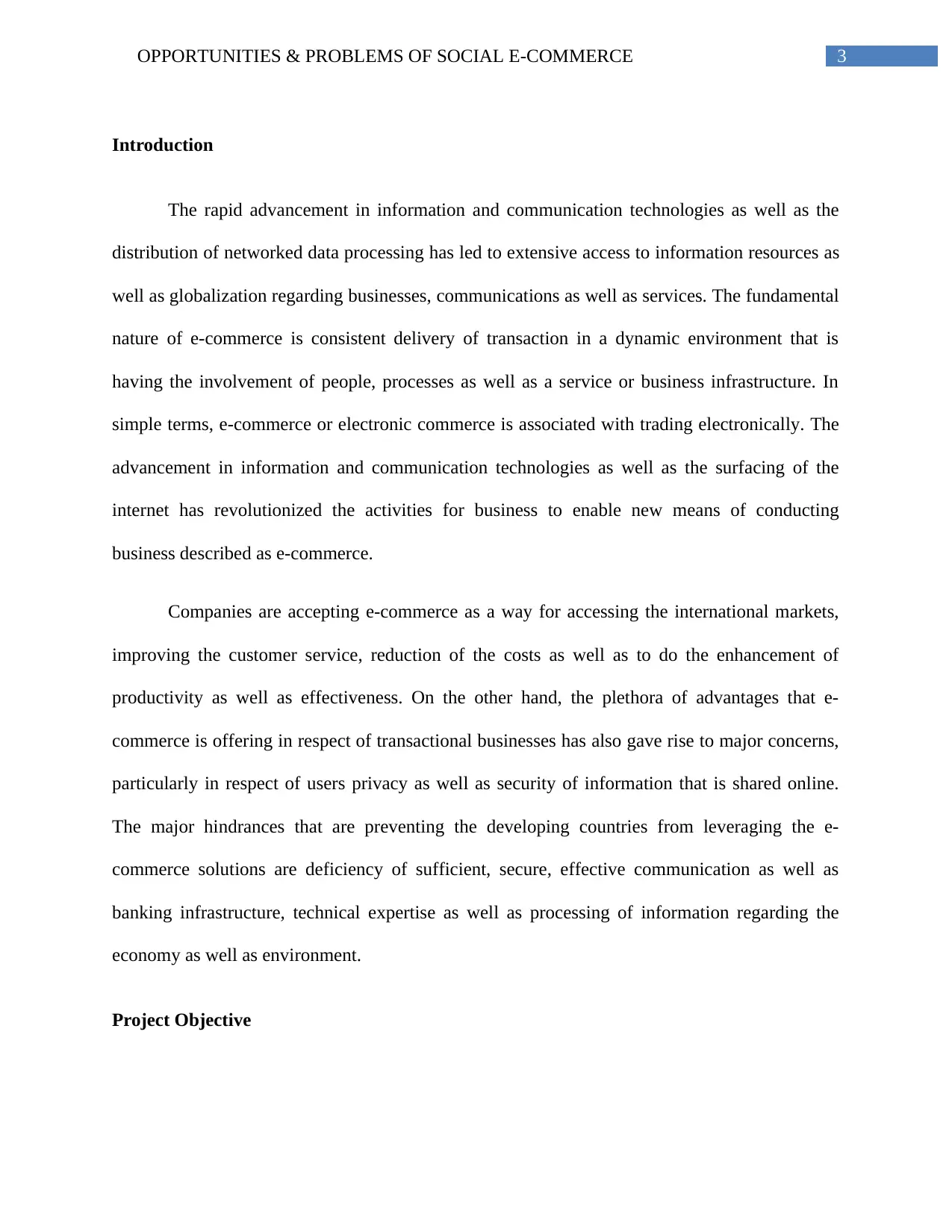
3OPPORTUNITIES & PROBLEMS OF SOCIAL E-COMMERCE
Introduction
The rapid advancement in information and communication technologies as well as the
distribution of networked data processing has led to extensive access to information resources as
well as globalization regarding businesses, communications as well as services. The fundamental
nature of e-commerce is consistent delivery of transaction in a dynamic environment that is
having the involvement of people, processes as well as a service or business infrastructure. In
simple terms, e-commerce or electronic commerce is associated with trading electronically. The
advancement in information and communication technologies as well as the surfacing of the
internet has revolutionized the activities for business to enable new means of conducting
business described as e-commerce.
Companies are accepting e-commerce as a way for accessing the international markets,
improving the customer service, reduction of the costs as well as to do the enhancement of
productivity as well as effectiveness. On the other hand, the plethora of advantages that e-
commerce is offering in respect of transactional businesses has also gave rise to major concerns,
particularly in respect of users privacy as well as security of information that is shared online.
The major hindrances that are preventing the developing countries from leveraging the e-
commerce solutions are deficiency of sufficient, secure, effective communication as well as
banking infrastructure, technical expertise as well as processing of information regarding the
economy as well as environment.
Project Objective
Introduction
The rapid advancement in information and communication technologies as well as the
distribution of networked data processing has led to extensive access to information resources as
well as globalization regarding businesses, communications as well as services. The fundamental
nature of e-commerce is consistent delivery of transaction in a dynamic environment that is
having the involvement of people, processes as well as a service or business infrastructure. In
simple terms, e-commerce or electronic commerce is associated with trading electronically. The
advancement in information and communication technologies as well as the surfacing of the
internet has revolutionized the activities for business to enable new means of conducting
business described as e-commerce.
Companies are accepting e-commerce as a way for accessing the international markets,
improving the customer service, reduction of the costs as well as to do the enhancement of
productivity as well as effectiveness. On the other hand, the plethora of advantages that e-
commerce is offering in respect of transactional businesses has also gave rise to major concerns,
particularly in respect of users privacy as well as security of information that is shared online.
The major hindrances that are preventing the developing countries from leveraging the e-
commerce solutions are deficiency of sufficient, secure, effective communication as well as
banking infrastructure, technical expertise as well as processing of information regarding the
economy as well as environment.
Project Objective
Paraphrase This Document
Need a fresh take? Get an instant paraphrase of this document with our AI Paraphraser
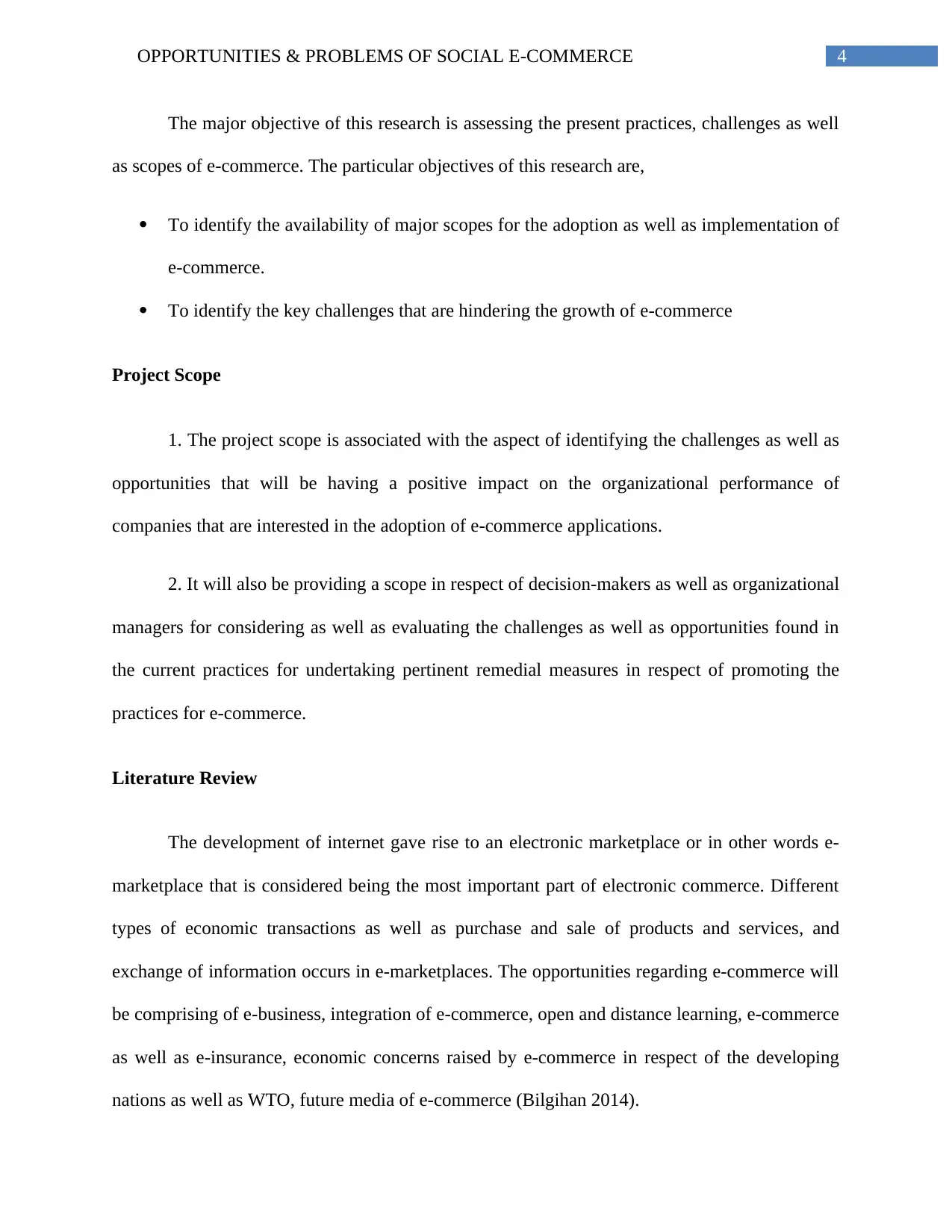
4OPPORTUNITIES & PROBLEMS OF SOCIAL E-COMMERCE
The major objective of this research is assessing the present practices, challenges as well
as scopes of e-commerce. The particular objectives of this research are,
To identify the availability of major scopes for the adoption as well as implementation of
e-commerce.
To identify the key challenges that are hindering the growth of e-commerce
Project Scope
1. The project scope is associated with the aspect of identifying the challenges as well as
opportunities that will be having a positive impact on the organizational performance of
companies that are interested in the adoption of e-commerce applications.
2. It will also be providing a scope in respect of decision-makers as well as organizational
managers for considering as well as evaluating the challenges as well as opportunities found in
the current practices for undertaking pertinent remedial measures in respect of promoting the
practices for e-commerce.
Literature Review
The development of internet gave rise to an electronic marketplace or in other words e-
marketplace that is considered being the most important part of electronic commerce. Different
types of economic transactions as well as purchase and sale of products and services, and
exchange of information occurs in e-marketplaces. The opportunities regarding e-commerce will
be comprising of e-business, integration of e-commerce, open and distance learning, e-commerce
as well as e-insurance, economic concerns raised by e-commerce in respect of the developing
nations as well as WTO, future media of e-commerce (Bilgihan 2014).
The major objective of this research is assessing the present practices, challenges as well
as scopes of e-commerce. The particular objectives of this research are,
To identify the availability of major scopes for the adoption as well as implementation of
e-commerce.
To identify the key challenges that are hindering the growth of e-commerce
Project Scope
1. The project scope is associated with the aspect of identifying the challenges as well as
opportunities that will be having a positive impact on the organizational performance of
companies that are interested in the adoption of e-commerce applications.
2. It will also be providing a scope in respect of decision-makers as well as organizational
managers for considering as well as evaluating the challenges as well as opportunities found in
the current practices for undertaking pertinent remedial measures in respect of promoting the
practices for e-commerce.
Literature Review
The development of internet gave rise to an electronic marketplace or in other words e-
marketplace that is considered being the most important part of electronic commerce. Different
types of economic transactions as well as purchase and sale of products and services, and
exchange of information occurs in e-marketplaces. The opportunities regarding e-commerce will
be comprising of e-business, integration of e-commerce, open and distance learning, e-commerce
as well as e-insurance, economic concerns raised by e-commerce in respect of the developing
nations as well as WTO, future media of e-commerce (Bilgihan 2014).
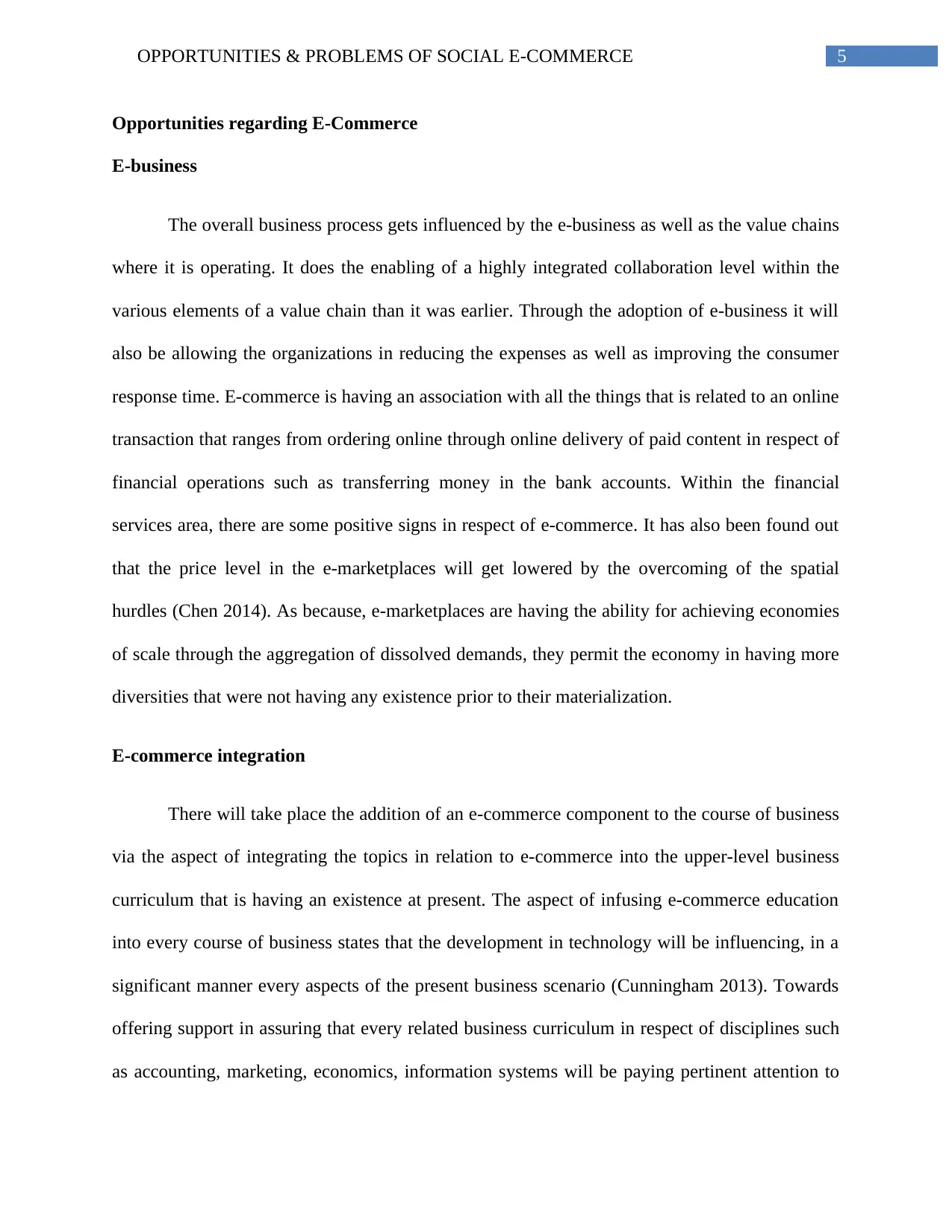
5OPPORTUNITIES & PROBLEMS OF SOCIAL E-COMMERCE
Opportunities regarding E-Commerce
E-business
The overall business process gets influenced by the e-business as well as the value chains
where it is operating. It does the enabling of a highly integrated collaboration level within the
various elements of a value chain than it was earlier. Through the adoption of e-business it will
also be allowing the organizations in reducing the expenses as well as improving the consumer
response time. E-commerce is having an association with all the things that is related to an online
transaction that ranges from ordering online through online delivery of paid content in respect of
financial operations such as transferring money in the bank accounts. Within the financial
services area, there are some positive signs in respect of e-commerce. It has also been found out
that the price level in the e-marketplaces will get lowered by the overcoming of the spatial
hurdles (Chen 2014). As because, e-marketplaces are having the ability for achieving economies
of scale through the aggregation of dissolved demands, they permit the economy in having more
diversities that were not having any existence prior to their materialization.
E-commerce integration
There will take place the addition of an e-commerce component to the course of business
via the aspect of integrating the topics in relation to e-commerce into the upper-level business
curriculum that is having an existence at present. The aspect of infusing e-commerce education
into every course of business states that the development in technology will be influencing, in a
significant manner every aspects of the present business scenario (Cunningham 2013). Towards
offering support in assuring that every related business curriculum in respect of disciplines such
as accounting, marketing, economics, information systems will be paying pertinent attention to
Opportunities regarding E-Commerce
E-business
The overall business process gets influenced by the e-business as well as the value chains
where it is operating. It does the enabling of a highly integrated collaboration level within the
various elements of a value chain than it was earlier. Through the adoption of e-business it will
also be allowing the organizations in reducing the expenses as well as improving the consumer
response time. E-commerce is having an association with all the things that is related to an online
transaction that ranges from ordering online through online delivery of paid content in respect of
financial operations such as transferring money in the bank accounts. Within the financial
services area, there are some positive signs in respect of e-commerce. It has also been found out
that the price level in the e-marketplaces will get lowered by the overcoming of the spatial
hurdles (Chen 2014). As because, e-marketplaces are having the ability for achieving economies
of scale through the aggregation of dissolved demands, they permit the economy in having more
diversities that were not having any existence prior to their materialization.
E-commerce integration
There will take place the addition of an e-commerce component to the course of business
via the aspect of integrating the topics in relation to e-commerce into the upper-level business
curriculum that is having an existence at present. The aspect of infusing e-commerce education
into every course of business states that the development in technology will be influencing, in a
significant manner every aspects of the present business scenario (Cunningham 2013). Towards
offering support in assuring that every related business curriculum in respect of disciplines such
as accounting, marketing, economics, information systems will be paying pertinent attention to
⊘ This is a preview!⊘
Do you want full access?
Subscribe today to unlock all pages.

Trusted by 1+ million students worldwide
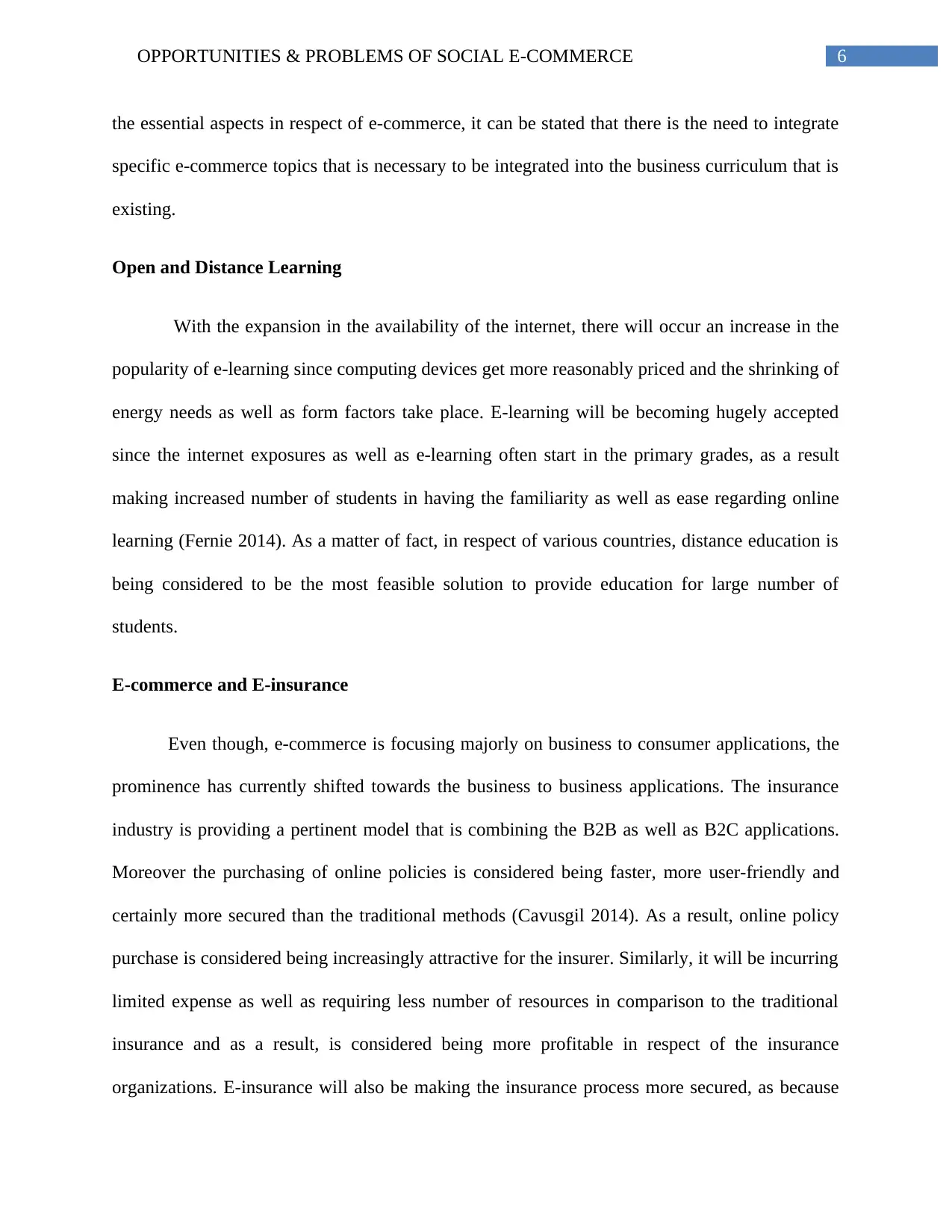
6OPPORTUNITIES & PROBLEMS OF SOCIAL E-COMMERCE
the essential aspects in respect of e-commerce, it can be stated that there is the need to integrate
specific e-commerce topics that is necessary to be integrated into the business curriculum that is
existing.
Open and Distance Learning
With the expansion in the availability of the internet, there will occur an increase in the
popularity of e-learning since computing devices get more reasonably priced and the shrinking of
energy needs as well as form factors take place. E-learning will be becoming hugely accepted
since the internet exposures as well as e-learning often start in the primary grades, as a result
making increased number of students in having the familiarity as well as ease regarding online
learning (Fernie 2014). As a matter of fact, in respect of various countries, distance education is
being considered to be the most feasible solution to provide education for large number of
students.
E-commerce and E-insurance
Even though, e-commerce is focusing majorly on business to consumer applications, the
prominence has currently shifted towards the business to business applications. The insurance
industry is providing a pertinent model that is combining the B2B as well as B2C applications.
Moreover the purchasing of online policies is considered being faster, more user-friendly and
certainly more secured than the traditional methods (Cavusgil 2014). As a result, online policy
purchase is considered being increasingly attractive for the insurer. Similarly, it will be incurring
limited expense as well as requiring less number of resources in comparison to the traditional
insurance and as a result, is considered being more profitable in respect of the insurance
organizations. E-insurance will also be making the insurance process more secured, as because
the essential aspects in respect of e-commerce, it can be stated that there is the need to integrate
specific e-commerce topics that is necessary to be integrated into the business curriculum that is
existing.
Open and Distance Learning
With the expansion in the availability of the internet, there will occur an increase in the
popularity of e-learning since computing devices get more reasonably priced and the shrinking of
energy needs as well as form factors take place. E-learning will be becoming hugely accepted
since the internet exposures as well as e-learning often start in the primary grades, as a result
making increased number of students in having the familiarity as well as ease regarding online
learning (Fernie 2014). As a matter of fact, in respect of various countries, distance education is
being considered to be the most feasible solution to provide education for large number of
students.
E-commerce and E-insurance
Even though, e-commerce is focusing majorly on business to consumer applications, the
prominence has currently shifted towards the business to business applications. The insurance
industry is providing a pertinent model that is combining the B2B as well as B2C applications.
Moreover the purchasing of online policies is considered being faster, more user-friendly and
certainly more secured than the traditional methods (Cavusgil 2014). As a result, online policy
purchase is considered being increasingly attractive for the insurer. Similarly, it will be incurring
limited expense as well as requiring less number of resources in comparison to the traditional
insurance and as a result, is considered being more profitable in respect of the insurance
organizations. E-insurance will also be making the insurance process more secured, as because
Paraphrase This Document
Need a fresh take? Get an instant paraphrase of this document with our AI Paraphraser
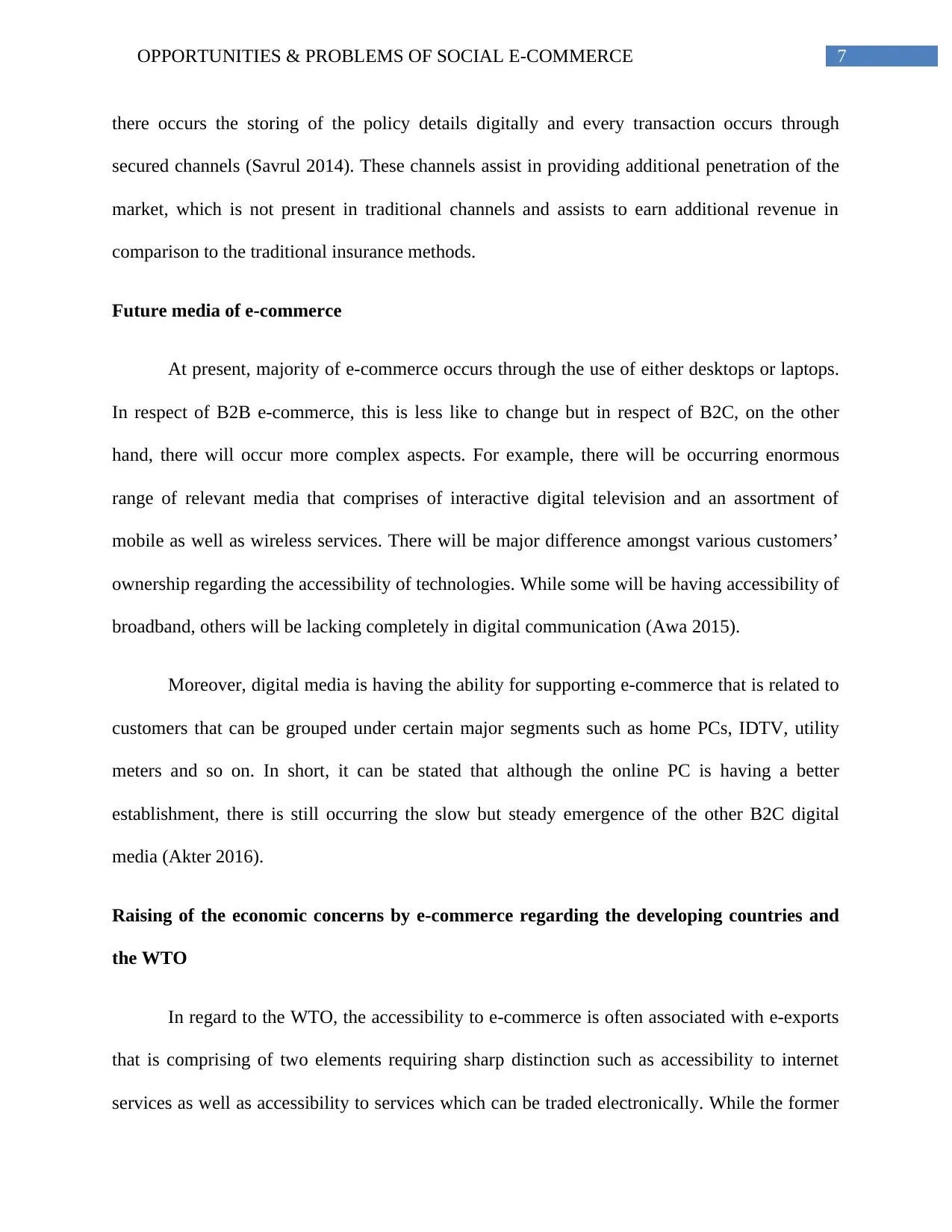
7OPPORTUNITIES & PROBLEMS OF SOCIAL E-COMMERCE
there occurs the storing of the policy details digitally and every transaction occurs through
secured channels (Savrul 2014). These channels assist in providing additional penetration of the
market, which is not present in traditional channels and assists to earn additional revenue in
comparison to the traditional insurance methods.
Future media of e-commerce
At present, majority of e-commerce occurs through the use of either desktops or laptops.
In respect of B2B e-commerce, this is less like to change but in respect of B2C, on the other
hand, there will occur more complex aspects. For example, there will be occurring enormous
range of relevant media that comprises of interactive digital television and an assortment of
mobile as well as wireless services. There will be major difference amongst various customers’
ownership regarding the accessibility of technologies. While some will be having accessibility of
broadband, others will be lacking completely in digital communication (Awa 2015).
Moreover, digital media is having the ability for supporting e-commerce that is related to
customers that can be grouped under certain major segments such as home PCs, IDTV, utility
meters and so on. In short, it can be stated that although the online PC is having a better
establishment, there is still occurring the slow but steady emergence of the other B2C digital
media (Akter 2016).
Raising of the economic concerns by e-commerce regarding the developing countries and
the WTO
In regard to the WTO, the accessibility to e-commerce is often associated with e-exports
that is comprising of two elements requiring sharp distinction such as accessibility to internet
services as well as accessibility to services which can be traded electronically. While the former
there occurs the storing of the policy details digitally and every transaction occurs through
secured channels (Savrul 2014). These channels assist in providing additional penetration of the
market, which is not present in traditional channels and assists to earn additional revenue in
comparison to the traditional insurance methods.
Future media of e-commerce
At present, majority of e-commerce occurs through the use of either desktops or laptops.
In respect of B2B e-commerce, this is less like to change but in respect of B2C, on the other
hand, there will occur more complex aspects. For example, there will be occurring enormous
range of relevant media that comprises of interactive digital television and an assortment of
mobile as well as wireless services. There will be major difference amongst various customers’
ownership regarding the accessibility of technologies. While some will be having accessibility of
broadband, others will be lacking completely in digital communication (Awa 2015).
Moreover, digital media is having the ability for supporting e-commerce that is related to
customers that can be grouped under certain major segments such as home PCs, IDTV, utility
meters and so on. In short, it can be stated that although the online PC is having a better
establishment, there is still occurring the slow but steady emergence of the other B2C digital
media (Akter 2016).
Raising of the economic concerns by e-commerce regarding the developing countries and
the WTO
In regard to the WTO, the accessibility to e-commerce is often associated with e-exports
that is comprising of two elements requiring sharp distinction such as accessibility to internet
services as well as accessibility to services which can be traded electronically. While the former
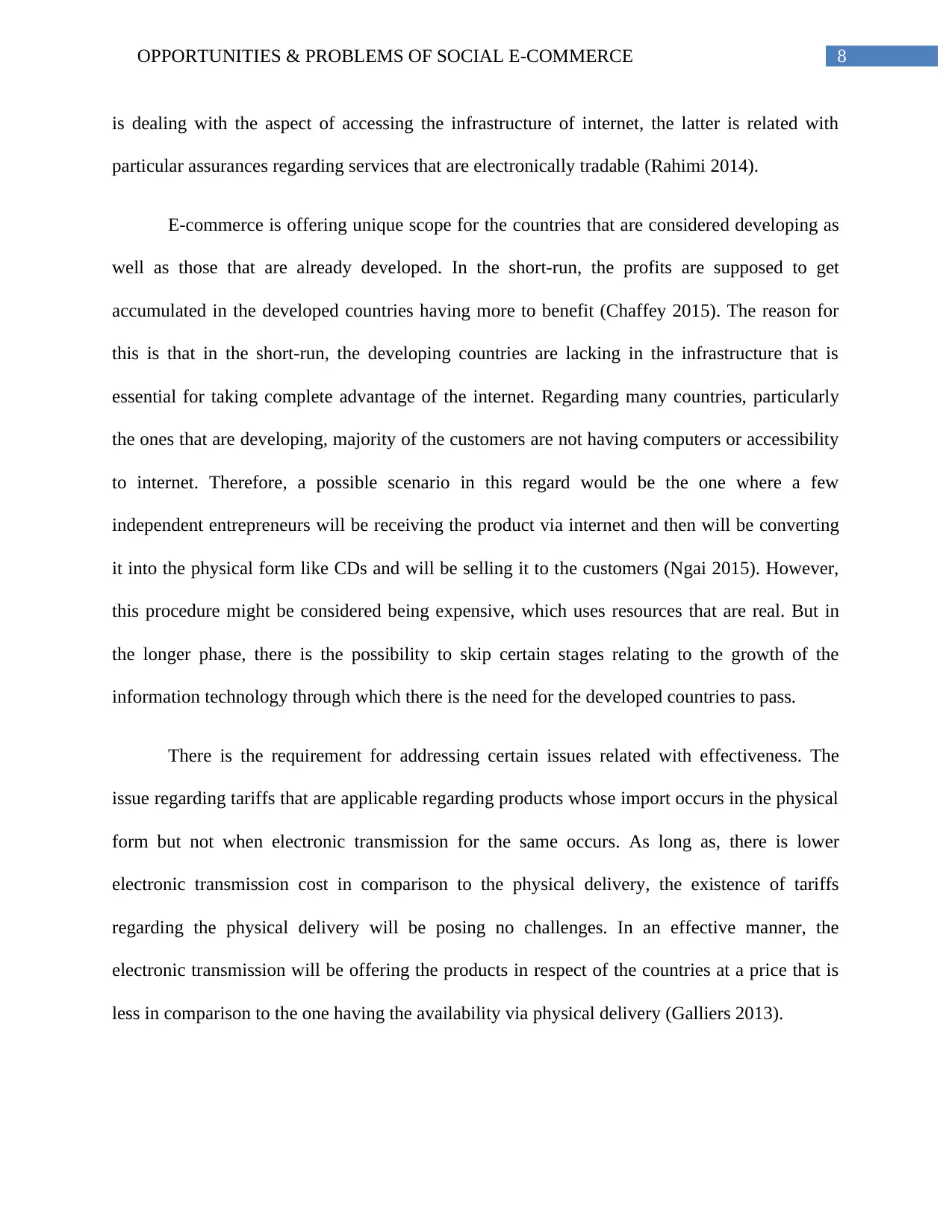
8OPPORTUNITIES & PROBLEMS OF SOCIAL E-COMMERCE
is dealing with the aspect of accessing the infrastructure of internet, the latter is related with
particular assurances regarding services that are electronically tradable (Rahimi 2014).
E-commerce is offering unique scope for the countries that are considered developing as
well as those that are already developed. In the short-run, the profits are supposed to get
accumulated in the developed countries having more to benefit (Chaffey 2015). The reason for
this is that in the short-run, the developing countries are lacking in the infrastructure that is
essential for taking complete advantage of the internet. Regarding many countries, particularly
the ones that are developing, majority of the customers are not having computers or accessibility
to internet. Therefore, a possible scenario in this regard would be the one where a few
independent entrepreneurs will be receiving the product via internet and then will be converting
it into the physical form like CDs and will be selling it to the customers (Ngai 2015). However,
this procedure might be considered being expensive, which uses resources that are real. But in
the longer phase, there is the possibility to skip certain stages relating to the growth of the
information technology through which there is the need for the developed countries to pass.
There is the requirement for addressing certain issues related with effectiveness. The
issue regarding tariffs that are applicable regarding products whose import occurs in the physical
form but not when electronic transmission for the same occurs. As long as, there is lower
electronic transmission cost in comparison to the physical delivery, the existence of tariffs
regarding the physical delivery will be posing no challenges. In an effective manner, the
electronic transmission will be offering the products in respect of the countries at a price that is
less in comparison to the one having the availability via physical delivery (Galliers 2013).
is dealing with the aspect of accessing the infrastructure of internet, the latter is related with
particular assurances regarding services that are electronically tradable (Rahimi 2014).
E-commerce is offering unique scope for the countries that are considered developing as
well as those that are already developed. In the short-run, the profits are supposed to get
accumulated in the developed countries having more to benefit (Chaffey 2015). The reason for
this is that in the short-run, the developing countries are lacking in the infrastructure that is
essential for taking complete advantage of the internet. Regarding many countries, particularly
the ones that are developing, majority of the customers are not having computers or accessibility
to internet. Therefore, a possible scenario in this regard would be the one where a few
independent entrepreneurs will be receiving the product via internet and then will be converting
it into the physical form like CDs and will be selling it to the customers (Ngai 2015). However,
this procedure might be considered being expensive, which uses resources that are real. But in
the longer phase, there is the possibility to skip certain stages relating to the growth of the
information technology through which there is the need for the developed countries to pass.
There is the requirement for addressing certain issues related with effectiveness. The
issue regarding tariffs that are applicable regarding products whose import occurs in the physical
form but not when electronic transmission for the same occurs. As long as, there is lower
electronic transmission cost in comparison to the physical delivery, the existence of tariffs
regarding the physical delivery will be posing no challenges. In an effective manner, the
electronic transmission will be offering the products in respect of the countries at a price that is
less in comparison to the one having the availability via physical delivery (Galliers 2013).
⊘ This is a preview!⊘
Do you want full access?
Subscribe today to unlock all pages.

Trusted by 1+ million students worldwide
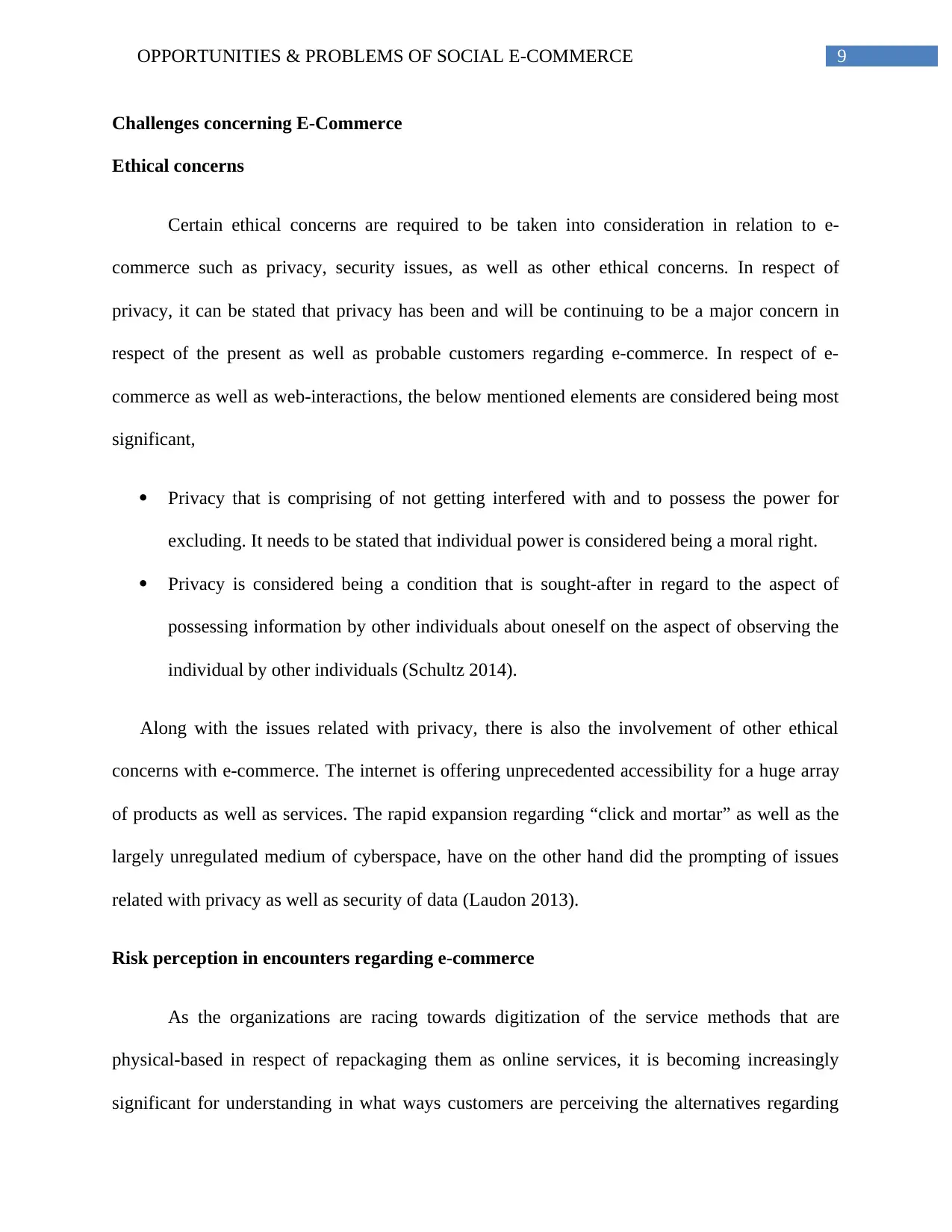
9OPPORTUNITIES & PROBLEMS OF SOCIAL E-COMMERCE
Challenges concerning E-Commerce
Ethical concerns
Certain ethical concerns are required to be taken into consideration in relation to e-
commerce such as privacy, security issues, as well as other ethical concerns. In respect of
privacy, it can be stated that privacy has been and will be continuing to be a major concern in
respect of the present as well as probable customers regarding e-commerce. In respect of e-
commerce as well as web-interactions, the below mentioned elements are considered being most
significant,
Privacy that is comprising of not getting interfered with and to possess the power for
excluding. It needs to be stated that individual power is considered being a moral right.
Privacy is considered being a condition that is sought-after in regard to the aspect of
possessing information by other individuals about oneself on the aspect of observing the
individual by other individuals (Schultz 2014).
Along with the issues related with privacy, there is also the involvement of other ethical
concerns with e-commerce. The internet is offering unprecedented accessibility for a huge array
of products as well as services. The rapid expansion regarding “click and mortar” as well as the
largely unregulated medium of cyberspace, have on the other hand did the prompting of issues
related with privacy as well as security of data (Laudon 2013).
Risk perception in encounters regarding e-commerce
As the organizations are racing towards digitization of the service methods that are
physical-based in respect of repackaging them as online services, it is becoming increasingly
significant for understanding in what ways customers are perceiving the alternatives regarding
Challenges concerning E-Commerce
Ethical concerns
Certain ethical concerns are required to be taken into consideration in relation to e-
commerce such as privacy, security issues, as well as other ethical concerns. In respect of
privacy, it can be stated that privacy has been and will be continuing to be a major concern in
respect of the present as well as probable customers regarding e-commerce. In respect of e-
commerce as well as web-interactions, the below mentioned elements are considered being most
significant,
Privacy that is comprising of not getting interfered with and to possess the power for
excluding. It needs to be stated that individual power is considered being a moral right.
Privacy is considered being a condition that is sought-after in regard to the aspect of
possessing information by other individuals about oneself on the aspect of observing the
individual by other individuals (Schultz 2014).
Along with the issues related with privacy, there is also the involvement of other ethical
concerns with e-commerce. The internet is offering unprecedented accessibility for a huge array
of products as well as services. The rapid expansion regarding “click and mortar” as well as the
largely unregulated medium of cyberspace, have on the other hand did the prompting of issues
related with privacy as well as security of data (Laudon 2013).
Risk perception in encounters regarding e-commerce
As the organizations are racing towards digitization of the service methods that are
physical-based in respect of repackaging them as online services, it is becoming increasingly
significant for understanding in what ways customers are perceiving the alternatives regarding
Paraphrase This Document
Need a fresh take? Get an instant paraphrase of this document with our AI Paraphraser

10OPPORTUNITIES & PROBLEMS OF SOCIAL E-COMMERCE
digitized e-service. E-service replacements might be appearing unfamiliar, artificial as well as
non-reliable when compared with traditional processes of service processing (Johnson 2017).
Customers might be believing that new internet-based methods of processing expose them
towards new probable threats associated with the risks of online fraudulence, identification theft,
as well as phising defrauds meaning the methods that are associated with the aspect of stealing
information that are regarded as confidential by the use of web-sites that are spoofed. This will,
as a result, be likely to create fear amongst the customers.
Conclusion
To conclude, it needs to be stated that e-commerce is creating new business
opportunities. It is also creating new scopes regarding education as well as academics. It seems
that there is a huge potential in respect of providing education related with e-business. Even
though, various organizations, establishments as well as communities have started taking
advantage of the potentiality relating to e-commerce, crucial challenges still persist that is
required to be prevailed over so that e-commerce can turn out to be an indispensable resource in
respect of the common individuals throughout the world.
digitized e-service. E-service replacements might be appearing unfamiliar, artificial as well as
non-reliable when compared with traditional processes of service processing (Johnson 2017).
Customers might be believing that new internet-based methods of processing expose them
towards new probable threats associated with the risks of online fraudulence, identification theft,
as well as phising defrauds meaning the methods that are associated with the aspect of stealing
information that are regarded as confidential by the use of web-sites that are spoofed. This will,
as a result, be likely to create fear amongst the customers.
Conclusion
To conclude, it needs to be stated that e-commerce is creating new business
opportunities. It is also creating new scopes regarding education as well as academics. It seems
that there is a huge potential in respect of providing education related with e-business. Even
though, various organizations, establishments as well as communities have started taking
advantage of the potentiality relating to e-commerce, crucial challenges still persist that is
required to be prevailed over so that e-commerce can turn out to be an indispensable resource in
respect of the common individuals throughout the world.

11OPPORTUNITIES & PROBLEMS OF SOCIAL E-COMMERCE
Reference
Akter, S. and Wamba, S.F., 2016. Big data analytics in E-commerce: a systematic review and
agenda for future research. Electronic Markets, 26(2), pp.173-194.
Awa, H.O., Ojiabo, O.U. and Emecheta, B.C., 2015. Integrating TAM, TPB and TOE
frameworks and expanding their characteristic constructs for e-commerce adoption by
SMEs. Journal of Science & Technology Policy Management, 6(1), pp.76-94.
Bilgihan, A., Okumus, F., Nusair, K. and Bujisic, M., 2014. Online experiences: flow theory,
measuring online customer experience in e-commerce and managerial implications for the
lodging industry. Information Technology & Tourism, 14(1), pp.49-71.
Cavusgil, S.T., Knight, G., Riesenberger, J.R., Rammal, H.G. and Rose, E.L.,
2014. International business. Pearson Australia.
Chaffey, D., 2015. Digital business and E-commerce management. Pearson Education Limited.
Chen, C.P. and Zhang, C.Y., 2014. Data-intensive applications, challenges, techniques and
technologies: A survey on Big Data. Information Sciences, 275, pp.314-347.
Cunningham, P. and Fröschl, F., 2013. Electronic business revolution: opportunities and
challenges in the 21st century. Springer Science & Business Media.
Fernie, J. and Sparks, L., 2014. Logistics and retail management: emerging issues and new
challenges in the retail supply chain. Kogan page publishers.
Galliers, R.D. and Leidner, D.E. eds., 2014. Strategic information management: challenges and
strategies in managing information systems. Routledge.
Reference
Akter, S. and Wamba, S.F., 2016. Big data analytics in E-commerce: a systematic review and
agenda for future research. Electronic Markets, 26(2), pp.173-194.
Awa, H.O., Ojiabo, O.U. and Emecheta, B.C., 2015. Integrating TAM, TPB and TOE
frameworks and expanding their characteristic constructs for e-commerce adoption by
SMEs. Journal of Science & Technology Policy Management, 6(1), pp.76-94.
Bilgihan, A., Okumus, F., Nusair, K. and Bujisic, M., 2014. Online experiences: flow theory,
measuring online customer experience in e-commerce and managerial implications for the
lodging industry. Information Technology & Tourism, 14(1), pp.49-71.
Cavusgil, S.T., Knight, G., Riesenberger, J.R., Rammal, H.G. and Rose, E.L.,
2014. International business. Pearson Australia.
Chaffey, D., 2015. Digital business and E-commerce management. Pearson Education Limited.
Chen, C.P. and Zhang, C.Y., 2014. Data-intensive applications, challenges, techniques and
technologies: A survey on Big Data. Information Sciences, 275, pp.314-347.
Cunningham, P. and Fröschl, F., 2013. Electronic business revolution: opportunities and
challenges in the 21st century. Springer Science & Business Media.
Fernie, J. and Sparks, L., 2014. Logistics and retail management: emerging issues and new
challenges in the retail supply chain. Kogan page publishers.
Galliers, R.D. and Leidner, D.E. eds., 2014. Strategic information management: challenges and
strategies in managing information systems. Routledge.
⊘ This is a preview!⊘
Do you want full access?
Subscribe today to unlock all pages.

Trusted by 1+ million students worldwide
1 out of 13
Related Documents
Your All-in-One AI-Powered Toolkit for Academic Success.
+13062052269
info@desklib.com
Available 24*7 on WhatsApp / Email
![[object Object]](/_next/static/media/star-bottom.7253800d.svg)
Unlock your academic potential
Copyright © 2020–2025 A2Z Services. All Rights Reserved. Developed and managed by ZUCOL.





